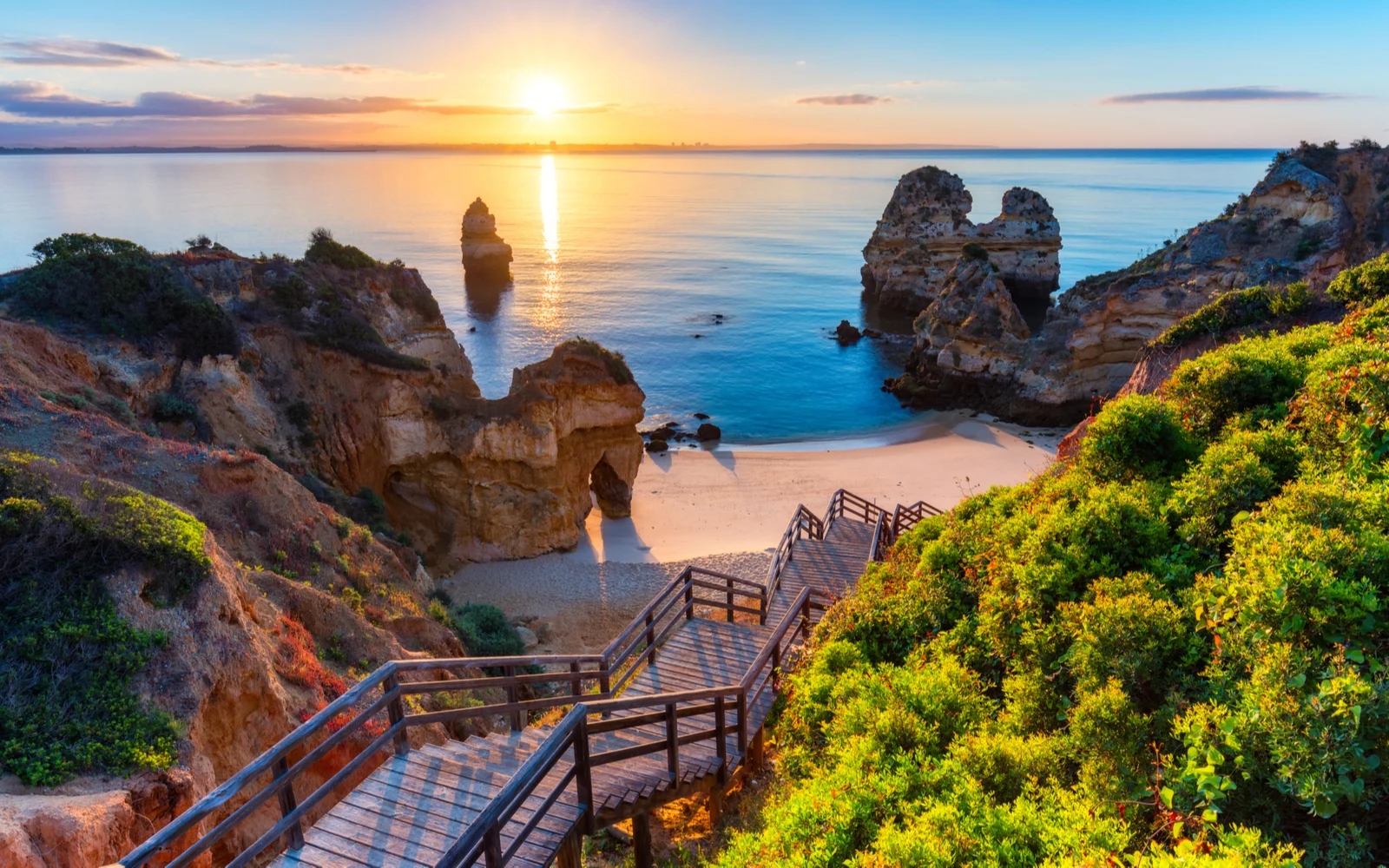What's the best time to visit Portugal?
The best time to visit Portugal is between June and October. While August through October is the busiest season, cheaper June and laid-back July offer a quieter experience for uninterrupted sightseeing, beach trips, and chances to explore colorful coastal cities like Lisbon and Porto on their medieval cobblestone streets.
Wondering about the best time to visit Portugal? This scenic, historic country has it all: golden beaches, flavorful cuisine punctuated with fresh seafood and port wine, incredible architecture, and buzzing coastal towns that draw you into a colorful, Mediterranean world.
Portugal is an enchanting place. Decorative azulejos tiles adorn pastel buildings in the coastal capital of Lisbon, port wine flows freely in the cellars and cafes lining the medieval streets of Porto, and impressive castles dating back to the 8th century (like Castelo dos Mouros) still stand on lush hilltops.
You’ll find Portugal a place you want to stay and explore in full with so much to see, experience, and discover around every corner of the narrow and artistic Portuguese cobblestone streets. But it really matters what season you choose for your visit.
The best time to visit Portugal is when the weather is warm and dry for sightseeing, festivals are in full swing, and the beaches are welcoming with sand gently warmed by the sun. But there are lesser-known times that can be great for a visit beyond the peak season.
You might be interested in saving some money by going during the cheapest time to visit or looking to avoid crowds during the low season. Maybe you’re looking for the months to avoid when you plan your travel dates.
In any case, we’ve got you covered with the best months to visit Portugal for the best weather, most affordable prices, and smallest crowds. We’ll also show you the worst time to visit so you don’t get caught by surprise during the chilly rainy season.
Overall Best Time to Visit Portugal
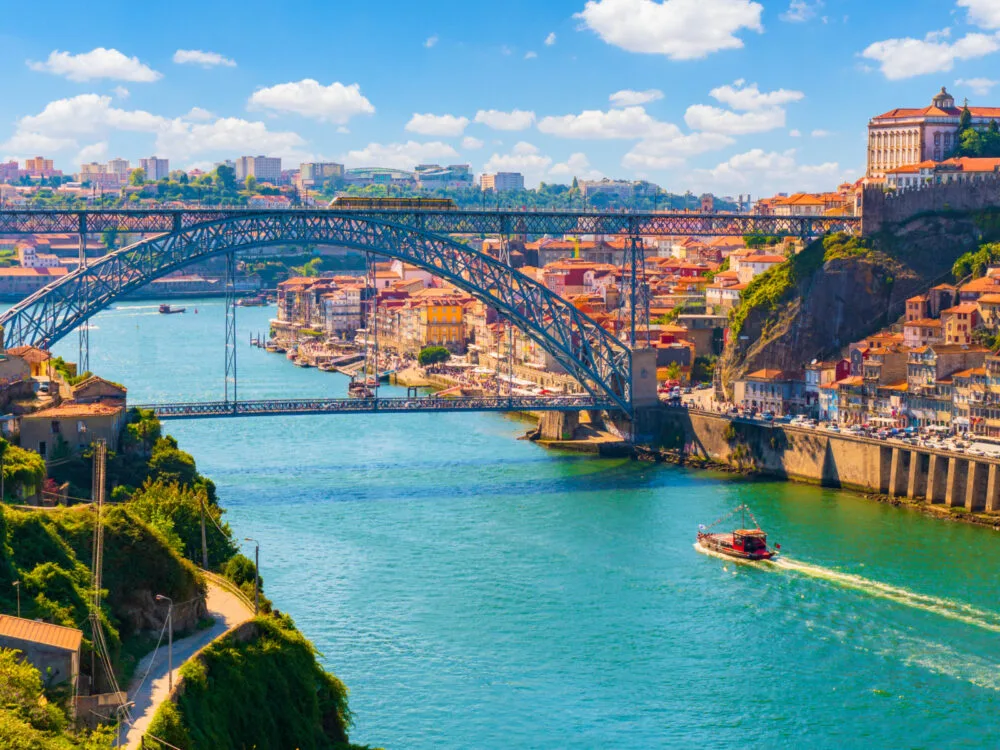
Rafael Bischof/Shutterstock
The best time to visit Portugal is between June and early October. Warm, dry weather is perfect for sightseeing, beaches, and cultural festivals that happen during the summer and fall months.
You can take your pick of travel dates between June and October, depending on the experience you want. The busiest months of the year — August through October — are crowded, but offer mild, pleasant weather. June and July are less crowded, warm, and ideal for sightseeing and beaches.
The weather in Portugal during these months is as fine as the porto wine you’ll sip here. With balmy daily highs in the 70s and low 80s, it’s never sweltering in Portugal, but you’ll find the best conditions for spending time on the beach during these months:
- June: 72-79°F; 1-5 rainy days
- July: 75-83°F; 1-2 rainy days
- August: 75-83°F; 1-3 rainy days
- September: 73-79°F; 2-6 rainy days
- October: 63-73°F; 5-11 rainy days
Sightseeing is a joy when the skies are blue and sunny and rain is limited. This dry season period starts to break apart come October, when more rainfall enters the country (especially in the north, like Porto), so coming early in the month alleviates this problem.
Porto is particularly mild year-round, with high temperatures ranging from 56°F to 75°F. Lisbon and its nearby beaches are warmer with average highs between 58°F and 83°F. In general, the south is warmer and drier than the northern regions — keep this in mind if you want the warmest weather.
It’s a great time to visit the stately São Jorge Castle in Lisbon and wander the streets lined with historic pastel-toned buildings. You can visit the National Azulejo Museum to see an array of the famous blue and white hand-painted tiles that adorn Portuguese architecture.
Hit the beaches less than an hour from Lisbon, some located in pristine parks. Praia da Figueirinha is a great option in Arrábida Natural Park, while Carcavelos Beach is busier with surf schools, beachfront eateries, and the imposing São Julião da Barra fort.
Check out 120+ sand sculptures, like pyramids and religious icons, at the FIESA International Sand Sculpture Festival in the Algarve (runs from March to August). Rent a buggy to see more of the 5-hectare display, visit the “fish spa,” and enjoy the snack bar.
Thinking it’ll cost you dearly to visit Portugal during the best months of the year? That’s not the case. We tallied up data from Google Hotels and Skyscanner to find the average nightly rate on Portuguese hotels and the lowest airfare by month:
- June: $112/night; flights from $493
- July: $122/night; flights from $598
- August: $127/night; flights from $533
- September: $122/night; flights from $455
- October: $99/night; flights from $422
While hotel and airfare costs are higher during the peak summer months of July and August, things get cheaper in the fall. That means you’ll be able to score great deals by visiting during June, September, or October.
And don’t forget about Portugal’s vibrant festival season, which really kicks off in May and lasts through September. There are tons of cultural festivals and events you can check out to get to know this country and its traditions better:
- Santo Antonio Festival (Jun) in Lisbon is a month-long affair celebrated with concerts, plays, city-wide exhibits and performances, decorated bairros (neighborhoods), and a parade on Avenida da Liberdade on June 12
- Arraial Lisboa Pride (Jun) brings a rainbow of celebrations and parades to Lisbon with parties, concerts, competitions, and vendor booths in the capital
- Rock in Rio Lisboa (Jun) is a music festival originating in Brazil with a June event in Lisbon with world-renowned live music acts and entertainment, like Doja Cat and Ed Sheeran, leading the lineup
- Festa de São João (Jun) is a Midsummer festival in Porto that honors St. John the Baptist with religious and non-religious events, including dancing, food, bonfires, a parade, and competitions
- Festa dos Tabuleiros (Jul) in Tomar happens once every 4 years, honoring fertility traditions with the famous Tabuleiros Parade of young women in white garb carrying platters stacked high with bread and flowers in offerings to the Holy Spirit
- Festa do Colete Encarnado (Jul) or “Red Vest Party” in Vila Franca de Xira is similar to the running of the bulls with locals wearing campinos (red waistcoats) and participating in races, tributes, dances, feasts, and a huge parade with concerts
- Feira de São Mateus (Aug/Sept) in Viseu is a 39-day event with a fair and amusement rides, concerts, food, competitions, pageants, marathons, and bike races
- Peregrinação de Fátima (Oct 13) is the second of two annual major pilgrimages to Fatima as locals travel to the site of Virgin Mary apparitions reported and witnessed by 3 child shepherds in 1917
With fairs, parades, and concerts rocking Portugal from June to October and affordable prices at the start and end of the summer and fall seasons, these dry, warm months are by far the best time to visit the country for a little bit of everything.
Cheapest Time to Visit Portugal
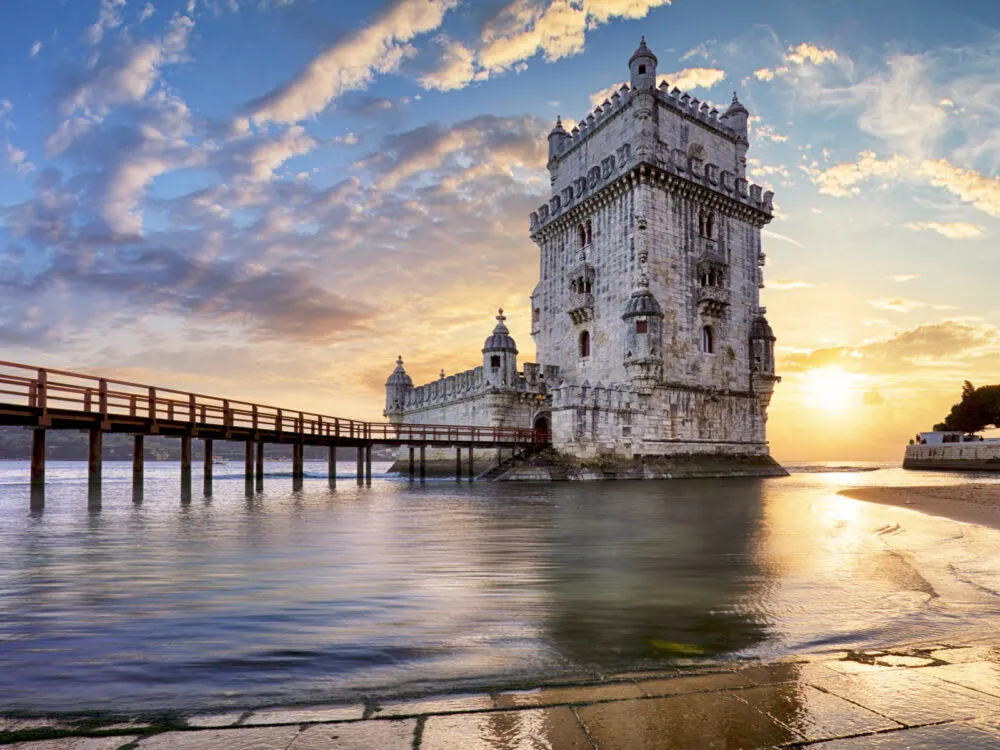
TTstudio/Shutterstock
November through February is the cheapest time to visit Portugal. During these months, winter weather and rain dampen tourism demands and drive down prices on hotels and flights.
When one travel period is much cheaper than others, it’s natural to wonder what the catch is. In this case, it’s the cooler, wetter weather that Portugal experiences in winter and a lack of the colorful festivals that bring coastal cities to life during the warmer months.
With highs from the upper 40s to the low 60s, it’s never freezing cold in Portugal, but this is the coolest period of the year. Beaches are less inviting with cloudy skies, sightseeing might require you to don a jacket or sweatshirt, and there’s more rain to contend with.
- November: 53-67°F; 8-11 rainy days
- December: 47-59°F; 7-11 rainy days
- January: 47-61°F; 6-11 rainy days
- February: 50-62°F; 5-9 rainy days
With all the cons of the winter season out of the way, let’s talk about the silver lining. These months aren’t the least busy, but they’re much less crowded than the peak months from June to October. It’s also the most affordable time to visit, saving you money on both your hotel and airfare.
Here’s what we found when going over Google Hotels pricing data and Skyscanner round trip airfare costs from the U.S. by month:
- November: $88/night; flights from $356
- December: $83/night; flights from $345
- January: $88/night; flights from $352
- February: $83/night; flights from $353
December is the cheapest month to visit overall, with a 7-day trip at an average hotel plus round trip flight costing as low as $926. February is next (as low as $934), then January ($968) and November ($972).
It’s the prime time of year for deals, but you can also take advantage of the season to venture down south where it’s still warm.
Lisbon is one of our favorite Portuguese cities to visit in winter because it’s much warmer and sunnier here than cities further north this time of year. It’s a great time to enjoy smaller crowds at places like the 16th-century Jerónimos Monastery, Belém Tower, and the ever-popular Pasteis de Belem for a Portuguese custard tart.
Catch a fado (traditional Portuguese music) show in the Chiado district, admire the holiday lights, visit the Wonderland Lisboa market, do a port tasting at Taylor’s Port Wine Shop, or just sightsee around the beautifully tiled and pastel-colored buildings.
Conditions are perfect to head to the Castelo dos Mouros, the hilltop Moorish castle of Sintra and UNESCO World Heritage site, You’ll also be able to check out some festivals, like:
- Feira Nacional do Cavalo Golegã (Nov) is a horse fair and equestrian show in Golegã filled with equine competitions, races, rallies, and carriage rides with wine and snack booths
- São Martinho Festival (Nov 11) is a bonfire (magusto) harvest party in towns around the country with its own motto: “É dia de São Martinho. Comem-se castanhas; prova-se o vinho!” meaning it’s St. Martin’s Day, we’ll eat chestnuts and taste wine”
- Carnival (Feb) parades with elaborate costumes, loud music, and abundant food and drinks happen across the country, but the biggest parades and celebrations are in Lisbon and the Algarve
Least Busy Time to Visit Portugal
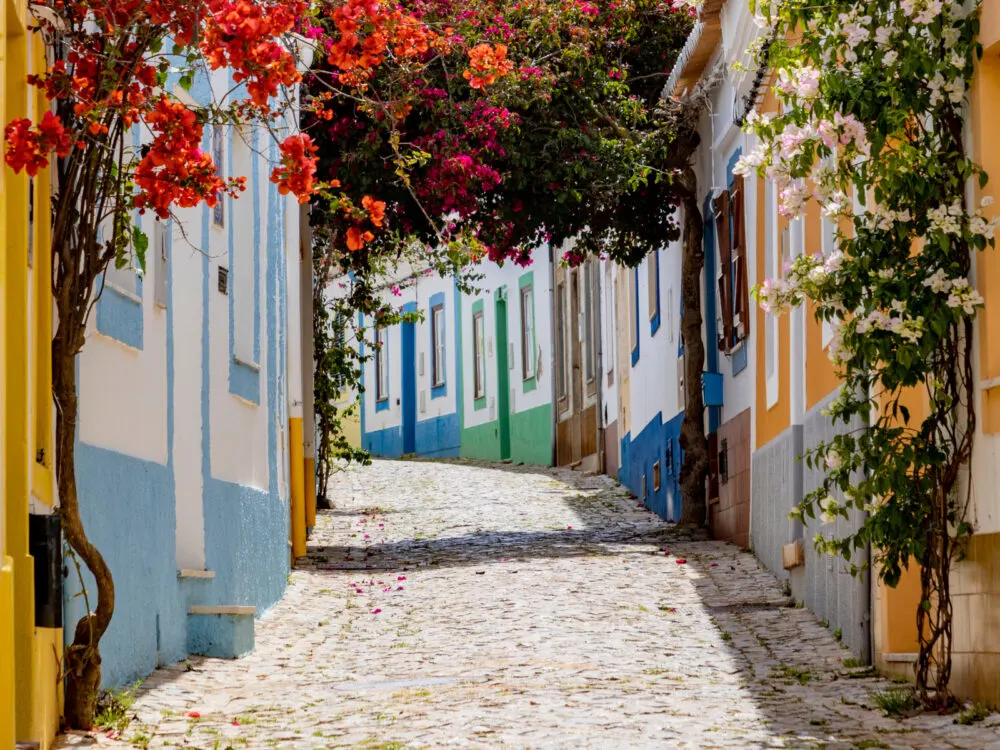
Travelview/Shutterstock
The least busy time to visit Portugal is between March and May. These relatively dry months are less crowded with mild weather across the country, especially down south around Lisbon.
Even if your main priority is avoiding peak season crowds, you won’t have to put up with heavy rain or cold weather if you come during March, April, or May. These springtime months see highs from the mid 50s to upper 60s and low 70s with less rain than winter:
- March: 55-65°F; 4-8 rainy days
- April: 58-68°F; 5-9 rainy days
- May: 65-73°F; 3-8 rainy days
Head to the mountainous Alvao Natural Park near Porto on the Olo River with forests lining the banks. The Fisgal waterfall creates a rainbow of mist in the park’s Bazal Zone. Journey another 3 hours to reach Serra da Estrela Natural Park, the biggest in Portugal with the country’s highest peak, summit lakes, majestic valleys and cliffs, and woodland paths to hike.
There’s a souvenir market with grilled meats and cheeses to enjoy. As far into the season as May, there will still be snow on the peaks of the mountains, creating a beautiful contrast between the burgeoning spring and summer and the cooler air at higher elevations.
Go on a port wine tour in Vila Nova de Gaia, where historic port wine cellars and tasting rooms (like Ferreira Cellars) cluster around the city center. There are excellent beaches here, like the sea glass-studded Praia de Miramar and Praia da Madalena with its bustling boardwalk.
You can check out charming Afurada, an ancient fishing village, in Vila Nova de Gaia to enjoy succulent grilled fish that’s still cooked on grills lining the streets and see old clothes washing tanks still in use by the district’s elders.
Take the scenic bike path from Afurada that leads you all the way to Espinho, past chapels built on the beach and the birder’s paradise of Douro Estuary Natural Reserve. It’s about an hour-long bike ride and so gorgeous along the way.
While March through May isn’t the cheapest time to stay in Portugal, hotel rooms cost around $100/night on average. But higher airfare makes it more expensive, so take a look at data from Google Hotels and Skyscanner to see what you might pay this time of year:
- March: $93/night; flights from $410
- April: $109/night; flights from $589
- May: $109/night; flights from $429
If you want to pay less for airfare and hotels, you’ll need to look at travel dates between cooler (and wetter) November and February instead. Attend some of the events that happen during the spring months, like:
- Semana Santa (Mar/Apr) is Holy Week in Portugal, celebrated with religious processions around the country featuring flowers, crosses, and twinkling lights; Braga and the Algarve have the biggest events
- Festa das Cruzes (May) in Barcelos is a festival of crosses with a pilgrimage to Alto Minho with traditional dancing, fireworks, music, flower carpets, and the Fair of the Crosses in the town’s public square
- Peregrinação de Fátima (May 13) means it’s time for devout Portuguese to take pilgrimages to the sanctuary at Fatima, the site where apparitions of the Virgin Mary appeared to young shepherds in 1917
For the less-crowded conditions and wonderfully mild temperatures this time of year, Portugal can be great to visit between March and May.
Worst Time to Visit Portugal

Sodel Vladyslav/Shutterstock
August (the most expensive month) and November (the most rainy days) are the worst months to visit Portugal. Both have pros and cons, but overall, there are better times to visit.
During August and November, you’ll encounter three circumstances that can make a trip to Portugal less enjoyable: High prices (August), big crowds (August), and heavy rainfall (November).
While November doesn’t see the increases in hotel costs and airfare like August, it’s a wet month with cool temperatures that makes it less enjoyable for a visit. August is one of the peak months, and while it has great weather, it’s crowded and expensive.
- August: 75-83°F; 1-3 rainy days
- November: 53-67°F; 8-11 rainy days
With just a couple of rainy days and warm highs in the 70s and 80s, August looks like the perfect month to visit. But these dreamy conditions draw tons of tourists, making it much more crowded than the early summer months of June and July.
With the increase in tourist demand comes higher prices on hotels and flights. And even though November doesn’t have these issues (it’s one of the cheapest months to visit), the cool weather and rain explains why prices dip so low this month.
- August: $127/night; flights from $533
- November: $88/night; flights from $356
These factors aside, either month can be potentially good for a visit — if you know what to expect.
In August, visit Porto and its medieval Ribeira (riverside) district, where a maze of Portuguese cobblestone streets create art along the ground with historic buildings, cafes, and homes lining either side. The dry weather makes perfect sightseeing conditions, but it will be crowded.
It’s a good time to stop by the ornate São Francisco Church in Porto with golden carvings in the Baroque style — it’s truly an opulent display, right alongside the lavish Palácio de Bolsa (Bolsa Palace) with an octagonal glass dome and painted ceilings.
November is better for cities and areas further south in Portugal, where the weather is warmer and a little drier. Highs will be closer to the mid-60s and you might see around 8 rainy days instead of 11+.
Check out Lisbon, the capital of Portugal, and Faro, the capital of the Algarve region. You’ll find lots of Moorish, medieval, and neoclassical architecture here along with an Old Town networked with cobblestone streets.
As far as festivals and events go, both months are light on activities. You can head to Viseu for the Feira de São Mateus in late August. Check out the Feira Nacional do Cavalo Golegã horse show in Golegã or the São Martinho Festival (harvest festival) on November 11 in towns across the country.
Portugal by Month: What to Expect
While Portugal’s weather is relatively mild year-round, fluctuating visitor numbers, prices, and festivals can make it more important to carefully choose which months you’ll travel during. Here’s what to expect during each month of the year.
January
As one of the cheapest months to visit Portugal, January experiences highs in the upper 40s to low 60s (warmer further south) with 6-11 rainy days. Flight prices and hotels are cheap this month — around $88/night on average with round trip airfare starting at $352.
February
February is another of the cheapest months to visit Portugal, bringing cool highs between 50°F and 62°F with 5-9 days of rain. It’s better than January for sightseeing and outdoor activities. Flights start around $353, while hotels cost about $83/night. Events include Carnival parades with dancing and colorful floats in Lisbon and the Algarve.
March
As one of the least busy months to visit Portugal, March is moderate in most ways with highs in the mid-50s to mid-60s, 4-8 rainy days, and fair pricing on hotels and airfare ($93/night average with flights as low as $410). Events include Holy Week processions in Braga, the Algarve, and other cities across Portugal.
April
Another of the least busy months to visit Portugal, April is warming up with highs in the upper 50s to upper 60s and 5-9 rainy days (pretty dry). Hotels cost about $109/night on average, while round trip flights run as low as $589 — expensive this month. When Easter falls in April, you can check out Holy Week processions in cities across the nation this month.
May
May is one of the least busy months to visit Portugal with balmy highs between 65°F and 73°F, 3-8 rainy days, and better prices on flights than April (as low as $429 round trip). Hotels should be around $109/night on average and events include the Festa das Cruzes in Barcelos and the pilgrimage to Fatima on May 13.
June
Possibly the best month to visit Portugal, June is less crowded, affordable, and has idyllic weather in the low-to-mid 70s. With 1-5 rainy days, it’s perfect for beaches, sightseeing, and exploring coastal cities. You’ll pay about $112/night for your hotel and $493+ to fly round trip. Events include Lisbon’s Santo Antonio Festival, Rock in Rio Lisboa, and Arraial Pride, with Festa de São João in Porto.
July
Another of the best months for a Portugal trip, July is as warm as it gets with highs in the upper 70s to low 80s. This is ideal for visiting beaches around Lisbon, exploring the inland parks for mountain hikes, and attending events like the fertility Festa dos Tabuleiros and Festa do Colete Encarnado. Hotels are about $122/night with flights starting at $598.
August
August is dreamy, but can be one of the worst months because it’s expensive and crowded. Warm highs from 75-83°F and 1-3 rainy days makes it lovely, but crowds can ruin sightseeing, beach days, and city exploration. You’ll pay $127/night for a hotel and upwards of $533 to fly. Events include the Feira de São Mateus in Viseu, which runs through early September.
September
September’s crowds continue the August trend as temperatures cool to 73-79°F and rainfall picks up slightly with 2-6 rainy days. The influx of visitors means prices stay elevated around $122/night for hotels, but flights start at $455 — cheaper than August.
October
As the final great month to visit Portugal of the year, October is better during the first half with highs between 63°F and 73°F. Rainfall increases to about 5-11 days of the month, but hotels are cheap at just $99/night on average. Flights are affordable, starting at $422, and events include the pilgrimages to the Fatima holy site on October 13.
November
November is one of the worst months to visit Portugal with cooler highs between 53-67°F and up to 11 rainy days. The silver lining is lower prices on hotels ($88/night) and flights (from $356), while events include the Feira Nacional do Cavalo Golegã and São Martinho Festival on November 11.
December
As the cheapest month to visit Portugal, December brings holiday cheer and decorations to the cities and cool temperatures between 47-59°F with 7-11 rainy days. It’s the rainy season, so flights and hotels are affordable this month at $83/night for accommodations and flights from $345.
Frequently Asked Questions
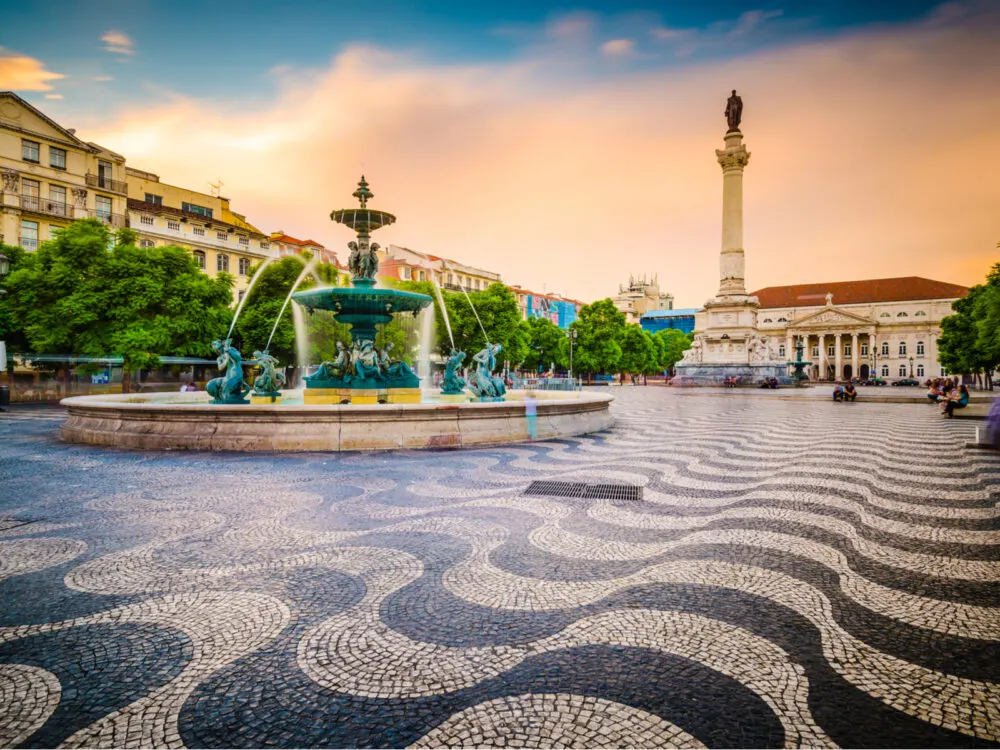
Sean Pavone/Shutterstock
Still wondering how you can pinpoint the best time to visit Portugal with your own travel goals in mind? Look over some of the most common questions other travelers had below to learn more.
What is the best month to go to Portugal?
June is the best month to go to Portugal because it offers dry, summery weather in the 70s without the high prices of the rest of the peak season. June is a less-crowded month that promises beautifully lush landscapes and chances to enjoy the beaches, cities, and mountains of Portugal.
What is the rainy season in Portugal?
October through March is the rainy season in Portugal, but November and December are the wettest months of the year here. Typically, the areas further north see more rainfall than southern Portugal, so head to cities like Lisbon and Faro to avoid the rain.
What time of year is Portugal cheapest?
Portugal is cheapest between November and February, when cool weather and rain keeps many tourists at bay. Prices on hotels and flights drop with the decreased demand. You can expect to pay anywhere from $83-$88/night on average this month and $345+ for a round trip flight.
Where is the best weather in Portugal?
The best weather in Portugal is down south, in cities like Lisbon (the capital) and the Algarve region (like Faro). Portugal experiences mild weather year-round, but southern regions are warmer and drier than areas further north for a longer beach season and better sightseeing conditions.
How many days in Portugal is enough?
Plan on spending 5-10 days in Portugal. Five days in Portugal is enough if you’ll be visiting 1-2 cities on your trip, while you’ll need 10 or more days to fully experience 3+ cities across the country, visit national parks, and do some exploring in smaller towns.
So, What’s the Best Time to Visit Portugal?
| 👍 Best Time to Visit | June-October |
| 💲 Cheapest Time to Visit | November-February |
| 🗓️ Least Busy Time to Visit | March-May |
| 👎 Worst Time to Visit | August & November |
The best time to visit Portugal overall is between June and October. June and July are quiet and warm, while August through October tends to see bigger crowds. Come between November and February if you’re looking for the cheapest hotels and flights.
The months of March through May offer the smallest crowds of the year for better sightseeing and a more laid-back trip, but you should try to avoid August (high prices and crowds) and November (lots of rain and cool weather) if your dates are flexible.
Portugal has so much to offer a traveler like yourself — historic architecture from castles to cathedrals, diverse landscapes from mountains to beaches, great food, and a vibrant culture that’s apparent in the festivals and pilgrimages that happen throughout the year.
You have a lot to look forward to if you’re planning a Portugal trip. Just make sure you take the best time to visit into account, and you’ll have a blast!



